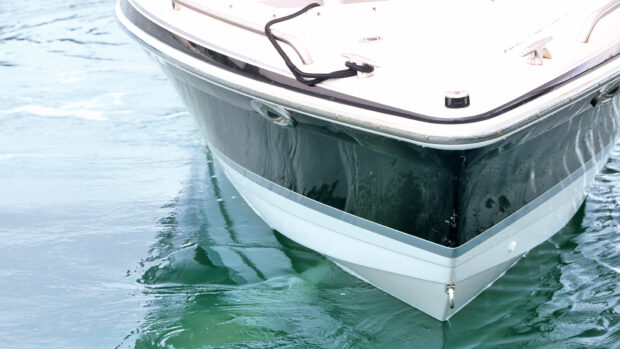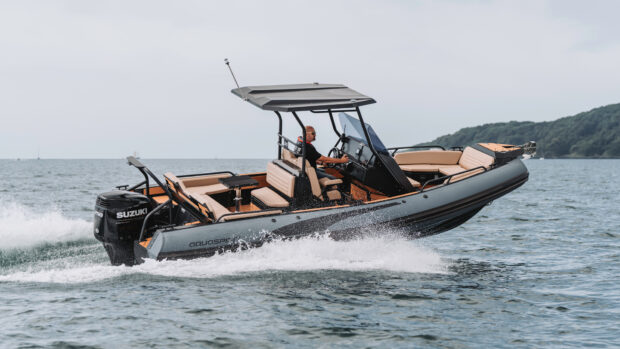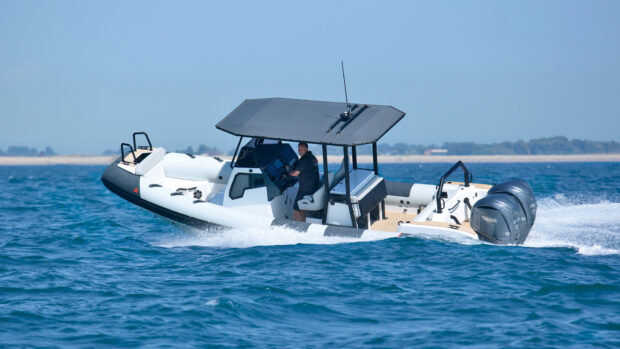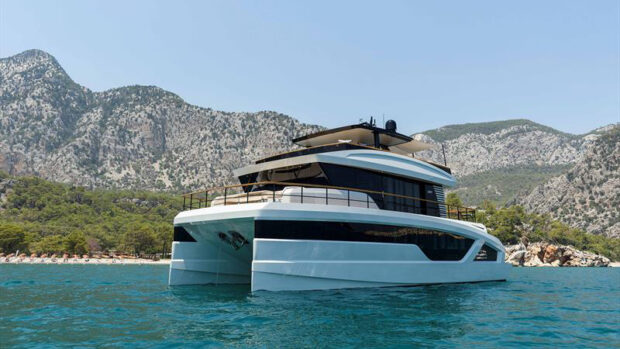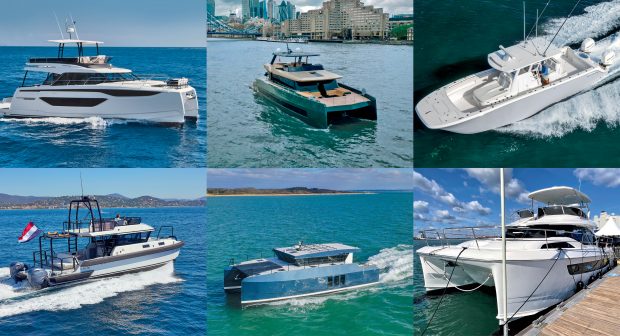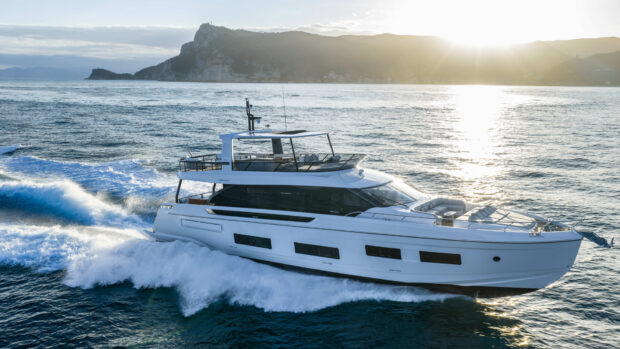Has the Plymouth yard’s latest flybridge cruiser, the Princess F58, got what it takes to leap straight to the top of its class? There was only one way to find out…
Either I’m getting older or Princess’s model replacement cycles are getting shorter because it only seems like a few years ago that we were testing the then brand-new Princess 55. At the time of our test in August 2018 we declared it to be the new class leader, citing its ‘supreme competence in every area’, its ‘stylish and brilliantly proportioned interior’ and a hull that ‘has no right to be as agile and engaging as it is’.
Seven years on and those words still ring true today and yet here is a brand new F58 offering a similar three-cabin, two-bathroom formula. So why all that effort and expense to update what was still a very strong package?
The answer, as always, is ever increasing customer expectations and the ferocious competition in this hotly-contested sector of the market. Last year’s new Fairline Squadron 58 raised the bar with its beach club stern featuring folding balconies and modular furniture, while Prestige countered with its new F5.7’s Ocean View galley and forward master cabin, then Galeon wowed everyone with its astonishingly big, bold and heavily glazed Galeon 560 FLY. Princess had to fight back and the Princess F58 is its emphatic response.

Despite its extra size and weight the F58 still handles very tidily. Photo: Paul Wyeth
Size matters
Looking at the raw dimensions, you could be forgiven for thinking not much had changed. The Princess F58’s LOA of 59ft 8in and maximum beam of 16ft 1in means it is less than two feet longer and only 1in wider than the F55.
However, this doesn’t tell the full story as the beam has been carried further forward, the air draft has increased and changes to the layout and packaging has enabled the designers to eke out valuable
extra inches everywhere that matters.
The displacement gives a better idea of the true scale of the increase, having swelled from 24.6 tonnes to 32.3 tonnes. Some of that can be put down to the heavier MAN engines fitted to the F58 but it’s also a reflection of all the extra GRP, glass and equipment that goes into it.
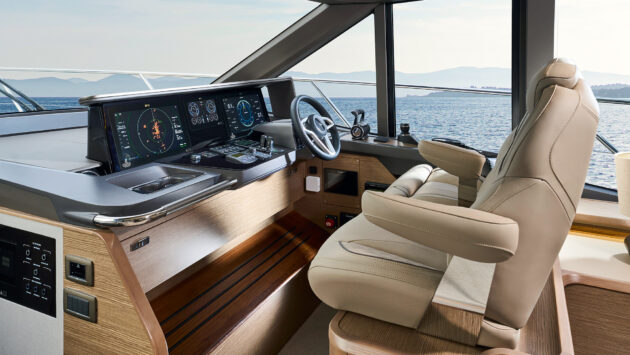
Supremely comfortable helm seats also adjust for reach. Note the large electric drop-down side window. Photo: Paul Wyeth
You can feel that extra volume and sophistication the minute you step onto the F58. That starts with what Princess rather optimistically describes as a beach club area. You won’t find any folding balconies, transformer platforms, convertible garages bars or sea-level sunpads here but what you will get (if you tick the right options boxes) are a big hydraulic platform large enough to take a Williams 345, a drop-down bench, a transom wet bar with a BBQ and sink, and a very cool little locker with a slide-out rack and charging point for a Seabob.
It’s not exactly revolutionary but it does keep Princess in the game while steering clear of too many moving mechanisms that add cost, complexity and the potential to go wrong.
It’s also worth pointing out that access to the crew cabin has been switched from a lifting hatch in the cockpit to a larger, more discreet entrance under the starboard stairs leading up from the bathing platform. Although the crew cabin fit-out is optional (as standard it’s just a big storage lazarette), the twin bunks and ensuite heads would make a handy overspill for kids or you can spec it as a larger day heads for the beach club.

The optional bucket chair to starboard makes for a more balanced array of seating. Photo: Paul Wyeth
Deck spaces
In the cockpit, Princess has ignored the current vogue for glass transoms and sideways-facing settees that give a view out over the stern, in favour of a more traditional forward-facing moulded-in dinette. It does have decent side extensions so you can sit on three sides of the folding table and there’s a special locker in the lower lobby for housing a pair of folding director’s chairs taking the capacity up to six. Optional side gates also make life easier when coming alongside a quay or lock wall, not to mention a great diving platform for kids.
A full length flybridge overhang provides plenty of shade and a place to hang the canopies from and, unlike the F55, there was no sign of spray being sucked into the cockpit under way during our test.

The galley window swings up to create a low-level bar into the cockpit. Photo: Paul Wyeth
Guardrails that extend all the way back to the cockpit and grabrails on the flybridge coaming allow for safe progress along the side decks, not just for easier crewing duties but also to give access to a much improved foredeck lounge. With two separate sunpads rather than a single central one, an optional chilled drinks locker and cushions that prop up both ways so they can act as headrests for the loungers or backrests for the aft facing seats, it’s a much more versatile space than it was on the F55.
Last but not least there’s the flybridge, which now has the option of a slicker-looking hard top with a wonderfully big fabric sunroof over the front half and an electric sun awning that extends right out over the aft end. The wet bar has also been moved from its usual position behind the helm seats to the port aft quarter.
Our only concern is what might happen if you knock a bottle over onto the platform below as there is no retaining lip. That aside, it’s a very effective use of the space that feels more open and still leaves room for a big dinette on the starboard side and companion seating next to the helm that converts to a sunbed when needed.

The dining table opposite the galley still folds in half to reveal a hand rail and cup holders. Photo: Paul Wyeth
Some might also question why they didn’t extend the flybridge further forward or add a skylight over the lower helm, although we suspect the former would have spoilt the F58’s impressively sleek looks.
For the first time on a boat below 60ft Princess has managed to find room for a dedicated dinette opposite the aft galley, rather than a coffee table in the lounge that lifts and extends for indoor dining. It does require a slightly longer, narrower galley than before with storage for plates and glasses spread around the saloon rather than immediately opposite but it also means you can eat and more importantly drink red wine above a wipe-clean wooden floor rather than stainable cream carpet!
It also leaves the slightly raised forward section of the saloon free for chatting, lounging, watching the 50in pop-up television or simply enjoying the view through those enormous side windows. The one thing we would recommend is adding the optional bucket style armchair on the starboard side of the saloon instead of a full length side board to create a more balanced, sociable seating layout.

The location of the bathroom and wardrobe add extra visual depth to the master cabin. Photo: Paul Wyeth
Princess F58 interior
Although you still only get three cabins and two bathrooms below deck (the second one has ensuite access from the VIP as well as the lobby) compared to the Prestige F5.7’s three bathrooms, what you do gain is a really impressive master suite with a bathroom and walk-in wardrobe behind the bed rather than squeezed into one of the forward corners.
This might not sound that transformative but the extra depth they provide not only makes the cabin look and feel considerably bigger but also adds a whole extra layer of sound insulation between the sleeping space and the engineroom, where both the generator and Seakeeper gyro stabiliser are likely to be running at night.

Forward VIP has ensuite access to the second bathroom but shares it with the twin cabin. Photo: Paul Wyeth
Ironically, this also highlighted the surprisingly loud hull slap at anchor. Resin infused hulls tend to be a bit noisier than thicker hand laid ones and while the sound of water lapping against the hull is a great deal nicer than the rumble of a generator, it might surprise less experienced guests how noisy this can be at night, especially in the VIP cabin where the hull chines first make contact with any wind-induced surface ripples.
On the plus side, floor space, bed size, headroom and natural light in both the VIP and twin cabin have all increased over the previous F55 while the detailing and finish has been ratcheted up a couple of extra notches too. They’ve even found space for a separate washer and dryer in the lobby as well as dedicated lockers for those director’s chairs and cockpit bar stools.

The two single beds in the third cabin can be joined to make a double. Photo: Paul Wyeth
With all that extra weight to shift and Princess’s preference for straight shafts over pod drives, they weren’t going to take any chances on power so in keeping with the rest of the boat’s shift upmarket, the standard engines are twin 1,000hp MAN V8s rather than the F55’s 800hp Volvo D13s.
Our test Princess F58 had the even more powerful optional 1,200hp MANs fitted. These are mighty engines and the eruption of torque that is unleashed once the turbos kick in makes light work of the F58’s bulk. We recorded a two way average top speed of 33.5 knots, giving plenty of leeway for mid-season fouling and a wide range of possible cruising speeds.
Those big engines do impact fuel efficiency, burning around 270lph at 20 knots compared to 211lph for the Fairline Squadron 58 and 184lph for the Prestige F5.7 at the same speed but neither rival comes close to matching the F58’s top speed or its effortless mid-range acceleration.

The beach club stern has a drop-down bench, a Seabob locker and an optional transom wet bar but no
folding terraces or fancy transformer platforms. Photo: Paul Wyeth
The good news is that there is very little penalty for upping the pace into the mid to late 20s as the litres per mile figure barely alters from 20-30 knots and sound levels only creep up marginally from a very subdued 67dB(A) to a still comfortable 74 dB(A).
Performance and handling
For such a big beast, it’s also impressively nimble. The steering was a little heavier than expected at the lower helm and inevitably there’s a brief delay between the application of lock and the big rudders taking effect but it’s still a surprisingly deft hull that you can flick from side to side with pleasing speed and no ill effects on comfort or stability.
Admittedly, we did have the largest possible gyro option running, a Seakeeper 18 instead of the usual 14, but this didn’t seem to adversely affect the handling, allowing just the right amount of lean in turns while quickly damping any roll at rest.

Conventional forward facing dinette in the cockpit. Photo: Paul Wyeth
We didn’t have much in the way of waves on the day of our test but the wake from passing ferries provided just enough of a challenge to know that while not completely immune to slamming at speed, it feels impressively safe, solid and unperturbed.
It does benefit from a dab of trim tabs to keep the bow planted but that provides exactly the kind of adjustability a keen skipper will want to cope with differing sea conditions. Nor do we have any complaints about either helm station, both of which enjoy very good ergonomics and visibility, aided on the main deck by a perfectly positioned electric helm window and the option of a third helm in the cockpit for stern-to berthing.
On that note the optional Aventic joystick, giving one-touch control of the throttles, steering and proportional bow and stern thrusters, may not be quite as slick as Volvo’s IPS system (rudders can’t hope to match the steering effect of vectoring pods) but it does make it easier for less experienced skippers to counter the effects of wind and tide during berthing manoeuvres.
Princess F58 specifications
LOA: 59ft 8in (18.20m)
BEAM: 16ft 1in 4.90m)
DRAFT: 5ft 0in (1.53m)
DISPLACEMENT: 32.3 tonnes
FUEL CAPACITY: 3300 litres
WATER CAPACITY: 630 litres
ENGINES: Twin MAN V8 1,000 or 1,200hp
CONTACT: princessyachts.com
Princess F58 costs and options
Price from: £1.9m ex tax
Engine upgrade to 1,200hp: £75,000
Flybridge hard top: £82,080
Seakeeper 18 gyro stabiliser:£151,000
Allure styling package: £63,670
Aventic Joystick: £39,075
Bow and stern thrusters: £23,900
Crew cabin fitout: £24,865
Hydraulic bathing platform: £34,425
 If you enjoyed this….
If you enjoyed this….
Motor Boat & Yachting is the world’s leading magazine for Motoryacht enthusiasts. Every month we have inspirational adventures and practical features to help you realise your sailing dreams, as well as tests and news of all the latest motorboats.
Plus you’ll get our quarterly Custom Yachting supplement where we share the last on offer in the superyacht world and at the luxury end of the market.
Build your knowledge with a subscription delivered to your door. See our latest offers and save at least 30% off the cover price.
Verdict
Princess is so good at this size and style of boat that it would be churlish to gripe about the slightly half-hearted attempt at a beach club, not least because we suspect most Princess owners would baulk at the idea of any gizmos or gadgets that might compromise its primary role as a supremely capable, comfortable, reliable cruiser. In that regard the new F58 hits its target with unerring accuracy. It looks remarkably elegant for a sub-60ft flybridge cruiser, it feels bigger than its dimensions suggest, it performs admirably and the build quality is every bit as refined and detailed as you’d expect. In short it achieves its goal of feeling like a considerably more modern, luxurious and sophisticated boat than its predecessor. We’d need to sea trial it back to back with its closest rivals to decide whether it’s the new class leader but it’s certainly right up there.
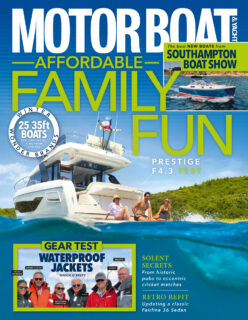


 If you enjoyed this….
If you enjoyed this….
